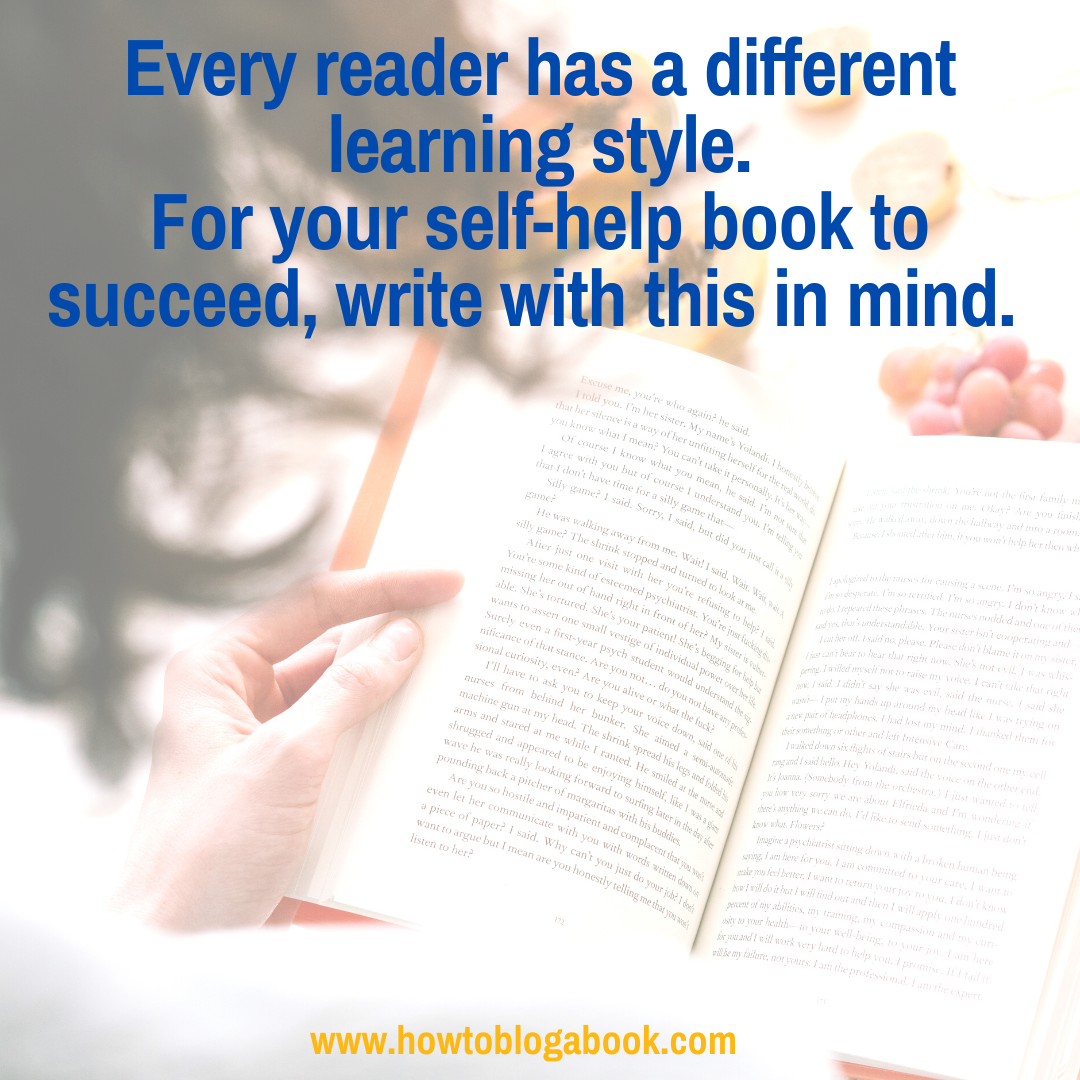Self-help books are powerful tools. According to NPD Group, U.S. sales of self-help books grew annually by 11 percent from 2013 to 2019, reaching 18.6 million volumes. Self-help books are popular because readers learn something useful in a manner that aligns with their most-effective learning style. Unlike taking a course or joining a coaching program that has a schedule, a book allows readers to progress through the transformational journey at their own pace.
More than ever before, people are increasingly open to taking ownership of their happiness and personal growth, but each reader has their own personal learning style. Therefore, when writing and planning your book, it’s helpful to keep these learning styles in mind. If you do, your book will connect with more readers.
Focus on two areas to strengthen your book’s audience connection by considering their learning style. Both are applicable when writing or blogging your self-help or transformational book.
1. Provide Real-World Examples
For readers to take your book seriously, include facts and figures to back up your anecdotes. The balance between those elements and the rest of the narrative depends on the type of self-help book you’re writing.
The key is balance.
Some of your readers will put more emphasis on facts and figures and others will be more interested in the stories that humanize the concepts you’re sharing. By providing both data and anecdotes, you allow readers to absorb the elements they are drawn to and skip the elements they don’t connect with.
How you co-present this information within your book is up to you. The key consideration is that you take a consistent approach throughout your book. For example, you could include key facts or data in a text box or identified them with a small icon. This strategy makes it easy for your readers to zero in on that information or skip it altogether.
You can do the same with anecdotes. They could start chapters or be placed in italics. Readers will easily identify these stories if that is what they prefer to read.
When you’re blogging your self-help book, you have more leeway with how facts and anecdotes are delivered.
Blogging your Book: Combining Facts and Anecdotes
- Write longer blog posts, including both elements for each topic or point you want to communicate, and organize them under headings and subheadings to make the post easy to scan.
- Include a mix of text and images to make a longer post more engaging.
Blogging your Book: Separating Facts and Anecdotes
- Instead of posting all the content together, break it into a series of shorter posts, which will make it easier to maintain a consistent blogging schedule. This approach also helps your reader access the style of content they prefer more easily. You could use a series of first-hand interviews to centralize your anecdotal content, and then use your categories and tags to make it easy to filter and find.
- When presenting facts, make them engaging. You can present the same information in text and images. Some readers will read both, using the images as an overview and text as a more in-depth review, whereas others may only scan the images.
- Another way to make the facts and data more digestible is to present them in an infographic. This quickly and clearly presents your content in a collection of concise chunks, and create a very sharable piece of content (especially on Pinterest). Infographics are especially useful when they include actions your readers need to remember. This encourages them to print them out, which is a good way to keep your website URL within easy reach.
2. Provide Frequent Contemplation Breaks
Transformation isn’t a quick sprint. Rather, it’s a strenuous hike that needs regular breaks to maintain momentum. Some readers may consume and absorb every word you’ve written, but we all know that there’s a generational shift towards short attention span.
Just because your book is broken into chapters doesn’t mean your reader will want to read the whole chapter before taking a break. This is especially true if you’ve crammed multiple concepts and ideas within each chapter.
So, when you’ve compiled your book’s chapters, do a review to see where there are natural pause points to insert a new heading or sub-heading.
Blogging your Book:
- Don’t try to cram too many concepts or ideas into a single blog post. Spread them out across multiple posts to prevent readers from getting overwhelmed.
- Individual posts can be connected with internal links, or you can create a summary post that includes links to all the posts with related content. A summary post acts as targeted index, and it provides readers with easy entry to similar areas of interest.
One of the challenges of writing a book is addressing your readers different ways of consuming content. It’s important to bear their learning styles in mind when blogging your book.
It may seem challenging to think about this when you write your first draft, but it’s something to consider during the review and editing phase—especially if you want to broaden your audience reach.
What tips have you incorporated into your content creation to appeal to your reader’s learning styles? Share your ideas in a comment below.
About the Author

Jay Artale abandoned her corporate career to become a digital nomad and full-time writer. She’s an avid blogger and a nonfiction author helping travel writers and travel bloggers achieve their self-publishing goals. Join her at Birds of a Feather Press where she shares tips, advice, and inspiration to writers with an independent spirit.
Photo courtesy of msgrafixx.

Leave a Reply